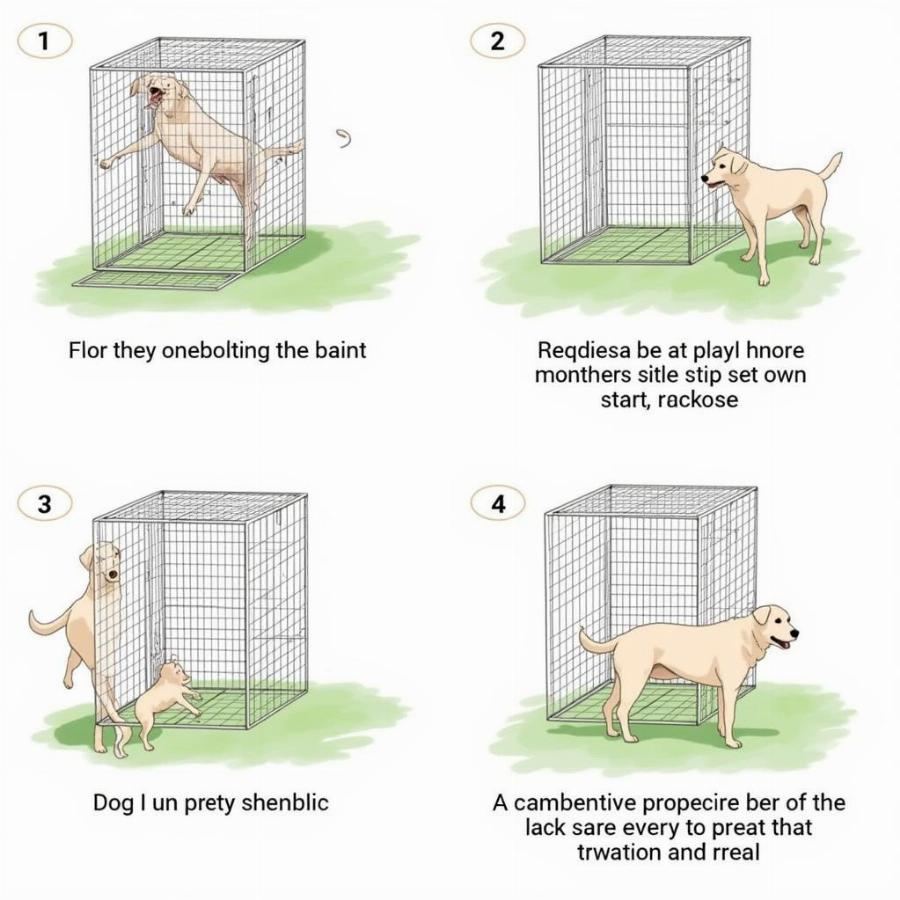Dog trap cages often evoke mixed reactions, but their responsible use can be crucial for animal welfare. This article dives deep into the world of dog trap cages, explaining their purpose, types, ethical considerations, and essential tips for safe and humane trapping. Whether you’re dealing with a lost pet or community concern, understanding dog trap cages is the first step to a successful and compassionate outcome.
When are Dog Trap Cages Necessary?
Dog trap cages are valuable tools in various situations where safely and humanely capturing a dog is paramount. Here are some common scenarios:
- Reuniting Lost Dogs: When a beloved pet goes missing, a trap cage can be a safe and effective way to bring them home.
- Rescuing Stray or Feral Dogs: Trap-neuter-release (TNR) programs often rely on trap cages to humanely capture feral dogs for spaying/neutering and medical care before returning them to their territory.
- Relocating Wildlife: While designed for dogs, trap cages can be used to safely relocate other animals, like raccoons or opossums, that might be encroaching on residential areas.
It’s crucial to remember that using a dog trap cage should always be a last resort after exhausting other options like luring the dog with food or utilizing a familiar scent.
Types of Dog Trap Cages
Dog trap cages come in various sizes and designs, each suited for different situations and dog sizes.
- Folding Trap Cages: These portable cages are lightweight and easy to transport, making them suitable for capturing smaller to medium-sized dogs.
- Heavy-Duty Trap Cages: Constructed from sturdy materials like steel, heavy-duty cages are ideal for larger dog breeds or dogs that might be anxious and more likely to try to escape.
- Single-Door vs. Double-Door Trap Cages: Single-door cages allow entry from one side, while double-door cages offer entry from both ends, potentially increasing trapping success.
Selecting the right size is crucial. A cage that’s too small can injure the dog, while a cage that’s too large might not trigger the trapping mechanism effectively.
Tips for Humane Trapping
Using a dog trap cage requires careful planning and execution to ensure the dog’s safety and well-being.
- Choose the Right Location: Place the trap in a familiar or secluded area where the dog has been spotted, minimizing stress and maximizing the chances of a successful capture.
- Bait the Trap Strategically: Use enticing bait like cooked chicken or hot dogs, placing it towards the back of the cage to encourage the dog to enter fully.
- Camouflage the Trap: Covering the trap cage with a blanket or tarp can create a sense of security, making the dog feel more comfortable entering.
- Monitor the Trap Regularly: Check the trap frequently to minimize the dog’s stress and ensure their safety once they are trapped. Never leave a trapped dog unattended for extended periods.
 Setting Up a Dog Trap Cage Humanely
Setting Up a Dog Trap Cage Humanely
Ethical Considerations and Safety Precautions
- Never Leave a Trap Unattended: Regular monitoring is critical to ensure the dog’s well-being and prevent potential injury or escape.
- Provide Food and Water: Once the dog is trapped, provide fresh water and, if appropriate, a small amount of food to keep them comfortable.
- Handle with Care: When approaching the trapped dog, do so calmly and quietly, avoiding any sudden movements that might frighten them.
- Consult Professionals: If you’re unsure about using a dog trap cage, contact your local animal control or a professional animal rescue organization for assistance.
“Using a dog trap cage requires a delicate balance of strategy and compassion,” says renowned veterinarian Dr. Emily Carter. “Prioritizing the dog’s well-being throughout the process is paramount.”
What to Do After Trapping a Dog
Once you’ve successfully and humanely trapped a dog, the next steps are crucial.
- Contact Animal Control or Rescue: Depending on the situation, contact your local animal control or a rescue organization to transport the dog safely.
- Check for Identification: If the dog has a collar and tags, contact the owner immediately.
- Provide Necessary Care: If the dog appears injured or distressed, seek veterinary attention immediately.
Conclusion
Dog trap cages, when used responsibly and ethically, can be invaluable tools for rescuing lost pets, managing stray populations, and ensuring both human and animal safety. Remember, the key lies in prioritizing the dog’s well-being throughout the process. By following the tips and guidelines outlined in this article, you can help make a positive difference in the life of a dog in need.
For further information and resources on dog care and safety, contact Beaut Dogs at [email protected].
Beaut Dogs is your go-to source for reliable and insightful information on the wonderful world of dogs. We provide comprehensive guides, expert advice, and a community of passionate dog lovers. Visit our website at https://beautdogs.com to learn more about responsible dog ownership and connect with fellow enthusiasts.